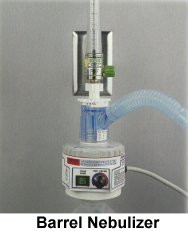|
Aerosols |
 |
Large-Volume Nebulizers - These units also have the capability for entraining room air to deliver a known oxygen concentration. They can deliver varying concentrations of oxygen. When using these units, you should always match or exceed the patient's peak inspiratory flow rates. This assures delivery of oxygen and nebulized particles. These units produce particle sizes between two and ten microns and may be heated to improve output. Centrifugal Room Nebulizers - This nebulizer works on the principle of a rotating disk that spins on a hollow tube. This action draws water up the hollow tube that acts as a center shaft. Once the water reaches the rotating disk (which is spinning at a rapid rate), it is thrown outward by centrifugal force through comb-like structures that break up the water and produce an aerosol. |
Although these are in fact nebulizers, they are used as room humidifiers. The aerosol particles are expelled into the room. Since they are very small particles, they evaporate to become humidity. Humidification is more effective if the door to the room is left closed.
Small-particle aerosol generator (SPAG) - This is a highly specialized jet-type aerosol generator designed to for administering ribavirin (Virazole), the antiviral recommended for treating high risk infants and children with respiratory syncytial virus infections.
Ultrasonic nebulizers - Ultrasonic nebulizers (USN) have been in use and production since the mid 1960s and have gained high popularity. Ultrasonic nebulizers work on the principle that high frequency sound waves can break up water into aerosol particles. This form of nebulizer is powered by electricity and uses the piezoelectric principle. This principle is described as the ability of a substance to change shape when a charge is applied to it.
An ultrasonic nebulizer contains a transducer that has piezoelectric qualities. When an electrical charge is applied, it emits vibrations that are transmitted through a volume of water above the transducer to the water surface, where it produces an aerosol. The frequency of these sound waves is between 1.35 and 1.65 megacycles, depending on the model and brand of the unit.
Their frequency determines the particle size of the aerosol. The transducers that transmit this frequency are of two types. One type is the flat transducer, which creates straight, unfocused sound waves that can be used with various water levels. The other type is a curved transducer, which needs a constant water level above it because its sound waves are focused at a point slightly above the water surface. if the water level falls below this point, the unit loses its ability to nebulize.
As stated, the frequency of an ultrasonic nebulizer determines the particle size of the aerosol. In ultrasonic nebulizers, the particle size falls in the range of .5 to 3 microns. The amplitude or strength of these sound waves determines the output of the nebulizer, which falls in the range of 0 to 3 ml/minute and 0 to 6 ml/minute. Ultrasonic nebulizers also incorporate a fan unit to move the aerosol to the patient. This fan action also helps cool the unit. The gas flow generated by this fan falls in the range of between 21 and 35 liters/minute. This flow of air also depends on the brand and model of the unit.
The transducer of an ultrasonic nebulizer is often found in the coupling chamber, which is filled with water. This water acts to cool the transducer and allows the transfer of sound waves needed for the nebulizer, which takes place in a nebulizer chamber. The nebulizer chamber is found just above the coupling chamber. These two chambers are usually separated by a thin plastic diaphragm that also allows sound waves to pass.
When studying ultrasonic nebulizers, remember that output is controlled by amplitude, and particle size is controlled by frequency. The advantages of ultrasonic nebulization are:
- high aerosol output
- smaller stabilized particle size
- deeper penetration into the tracheobronchial tree (alveolar level)
Ultrasonic nebulizers are useful in the treatment of thick secretions that are difficult to expectorate, and they can help to stimulate a cough. The therapy can be delivered through a mouthpiece or face mask. Therapy can be given with sterile water, saline or a mixture of the two.
Although IPPB has been used to deliver aerosolized drugs from a SVN, the consensus of clinical findings is that IPPB delivery of aerosolized medication is no more clinically effective than simple, spontaneous, unassisted inhalation from SVNs. If the patient is able to breathe spontaneously without machine support, the use of IPPB for delivery of aerosolized is not supported for general clinical or at-home use, and should be reserved for patients who are not capable of taking deep, coordinated breaths.